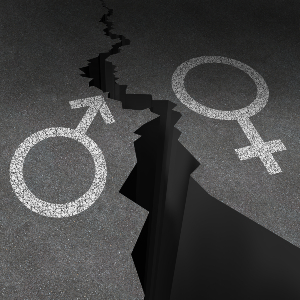
Data’s gender gap manifests and permeates society in a wide variety of detrimental ways. One area where it is the most immediately dangerous is medicine. There is a prevalence of research on most prominent and common health issues for men, however you find a lack of funding and properly conducted studies when you look at common health issues that primarily or exclusively affect women. The lack of representation in these trials leads to ineffective medication, a lack of proper diagnoses, and sometimes death.
Female bodies have been historically excluded from medical research, resulting in medicine and practices that put them at higher risk of illness and death. The top cause of death for American women is cardiovascular disease, however “[…] only one third of cardiovascular clinical trial subjects are female and only 31% of cardiovascular clinical trials that include women report results by sex.”[1] This causes issues, as the majority of patients studied have symptoms exclusive to men, and such symptoms become understood as the norm. Most of us have heard about the tell-tale signs of a heart attack: chest pain, tingling or numbness in the left arm, and shortness of breath. We have long believed that such symptoms were the same across the board, however it has come to light in recent years that women experience heart attacks differently. They are far more likely to have fatigue, nausea, cold sweats, and heartburn during the attack.[2] By both not including an equal number of participants across genders and not separating studies’ data by gender, researchers are depriving the public of potentially life-saving data and information.
One crucial women’s health issue that is often kept out of the public eye because many think it is “gross” is menstruation. 90% of people who have periods report unsavory symptoms related to mood and physical pain[3]. This is particularly relevant to me. Due to preexisting medical conditions, I am unable to take birth control, and therefore have a period every month. The associated pain (predominantly abdominal cramping) is so intense that I take a cocktail of CBD, various over the counter painkillers, and a prescribed dose of naproxen, and am still immobilized for 1-2 days per month. The pain is such that I miss work and social obligations every time and can sometimes be found curled up in bed, literally screaming. I don’t share this to make anyone uncomfortable, though I know talk of menstruation often does. I share this because doctors have deemed such pain normal and unavoidable. I cannot conceive of a men’s health issue where completely debilitating pain for one out of every fifteen days would be called normal.
One reason why such severe menstrual pain is not identified as a pressing issue is the lack of research on the topic. 40% of women– more than 20% of the US’s total population, do not respond to currently available treatments for menstrual pain, and there is a lack of funding made available to pursue further cures[4]. However, there is a surplus of funding available for studies on erectile dysfunction, which affects a mere 19% of men– less than 10% of the total population. In fact, for every study conducted on premenstrual syndrome, there have been five studies conducted about erectile dysfunction. While the two health issues are not the same, there is something to be said for the fact that we have five times as much room to study a secondary men’s health issue than we do for a health issue that nearly half of the population’s bodies force them into on a monthly basis. This is a massive gap in terms of data that is necessary to support the general population’s well-being. And it is deadly. An estimated 3-8% of menstruating women experience Premenstrual Dysphoric Syndrome, which causes such a high degree of mental and physical pain that 15% of those who have it attempt suicide due to the condition[5] at some point in their lives. By giving preference to studies about non-fatal men’s issues, we are taking resources away from clinical trials and research that could save thousands of women’s lives each year.
According to the American Academy of Family Physicians, this gap only grows when you account for women of varying racial backgrounds. In 2015, the FDA approved a drug to treat the spread of multiple myeloma. Although 20% of Americans who are diagnosed with that form of cancer are Black, fewer than 2% of participants in the clinical trial were Black[6]. In fact, as of 2017, less than 2% of more than 10,000 clinical trials for cancer treatment that were funded by the National Institutes of Health met the agency’s own self-imposed diversity goals. With nearly 40% of Americans identifying as non-white, and over half of Americans being female, the lack of consideration for racial and gender diversity in clinical trials hits women of color the hardest, as do most health-effecting issues in the country.
The disparity between our overall population and the representation allotted in clinical trials is a critical issue, the reversal of which could save an unquantifiable amount of pain and mortality daily. According to Ricardo Rojo, the Clinical Trial Diversity Lead at Pfizer Medical, “In order to better help patients and to understand their needs from a clinical trial, we need to make sure that the patients in the trial truly represent the age, race, and gender of those who have the disease.” If we fail to do so, we are effectively saying that white, middle aged men are the one group of people who deserve proper treatment for medical issues. Only by properly collecting and distributing data on how health issues affect all populations can we begin to move toward medical equity.
[1] https://www.theguardian.com/lifeandstyle/2015/apr/30/fda-clinical-trials-gender-gap-epa-nih-institute-of-medicine-cardiovascular-disease
[2] https://theheartfoundation.org/2017/03/29/heart-attack-men-vs-women/
[3] https://www.independent.co.uk/news/science/pms-erectile-dysfunction-studies-penis-problems-period-pre-menstrual-pains-science-disparity-a7198681.html
[4] https://www.teenvogue.com/story/over-half-men-think-sexism-over
[5] https://iapmd.org/female-suicide
[6] https://www.aafp.org/news/blogs/leadervoices/entry/20181204lv-clinicaltrials.html
